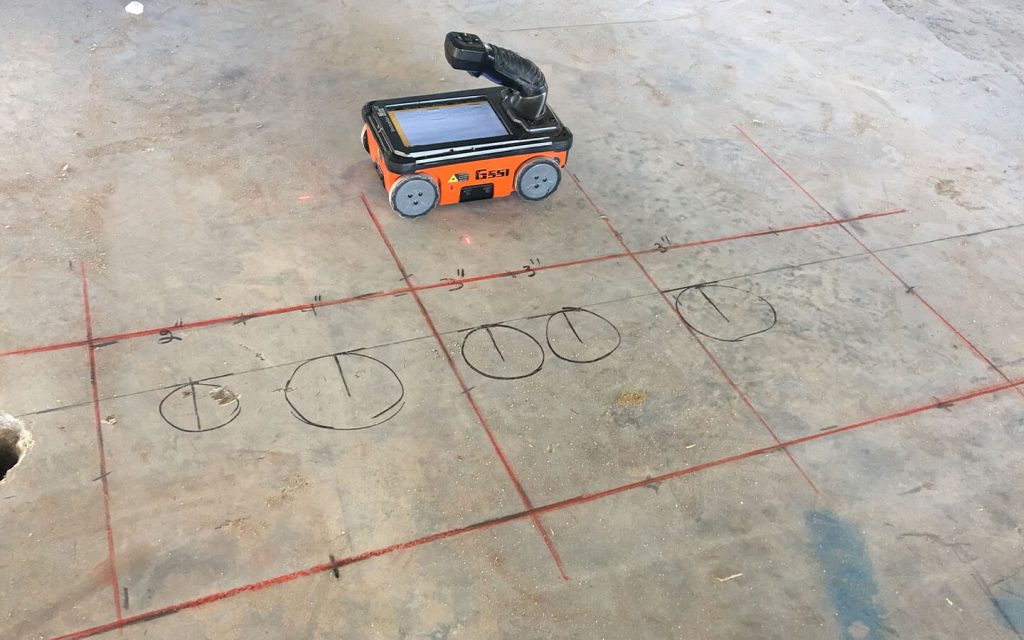Past the Surface: Leveraging Advanced Concrete Scanning Techniques for Unmatched Accuracy and Understanding
Advanced concrete scanning methods have actually arised as crucial tools in this quest, offering a look below the surface to unveil a globe of vital insights. By utilizing innovative technologies, experts can discover abnormalities, evaluate the problem of concrete structures, and make notified decisions that form the program of tasks.
Importance of Advanced Concrete Scanning
The importance of making use of advanced concrete scanning techniques hinges on the unmatched accuracy they supply for detecting sub-surface abnormalities and making certain architectural stability. By employing cutting-edge innovations such as ground-penetrating radar (GPR), electro-magnetic induction, and progressed finder imaging, building specialists can dig underneath the surface area of concrete frameworks with a level of precision that much exceeds traditional examination methods. Concrete Scanning. These techniques enable the recognition of covert hazards like rebar deterioration, spaces, conduits, or post-tension cables that can compromise the stability and safety and security of a framework with time
Furthermore, advanced concrete scanning offers vital understandings into the overall condition of a concrete element without the demand for intrusive measures, minimizing the risk of causing damage throughout the evaluation process. The capacity to determine the exact location and depth of prospective concerns permits targeted fixings and upkeep, eventually lengthening the life-span of the structure and optimizing its performance. Essentially, the significance of advanced concrete scanning can not be overemphasized in the realm of building and construction and facilities upkeep, where precision and dependability are critical.
Sorts Of Cutting-Edge Technologies

Anomalies and Problem Detection

Along with GPR, concrete scanning methods like thermography and impact-echo screening are likewise effective in spotting abnormalities and issues. Thermography utilizes infrared technology to pop over to these guys identify variations in surface area temperature level, suggesting potential areas of issue such as delamination or dampness access. On the various other hand, impact-echo screening includes assessing acoustic reactions to identify spaces, cracks, and other flaws within the concrete. By leveraging these innovative methods, experts can proactively address structural issues, making certain the longevity and safety of concrete structures.
Assessing Concrete Problem
Exactly how can designers properly review the problem of concrete structures to guarantee their long life and safety and security? Assessing the concrete problem is an important facet of maintaining facilities stability. Various innovative concrete scanning techniques are used for this objective. Ground-penetrating radar (GPR) is commonly utilized to evaluate the inner framework of concrete, detecting voids, fractures, and various other abnormalities that might compromise its stamina. In addition, impact-echo screening can give understandings into the density and honesty of concrete aspects. Ultrasonic pulse speed testing is an additional beneficial approach for reviewing concrete high quality by determining the speed of sound waves via the product.
Furthermore, visual his explanation examination continues to be a fundamental component of concrete problem assessment. Engineers aesthetically check out the surface area for signs of damage, such as spalling, fracturing, or staining. Combining non-destructive screening approaches with aesthetic assessments permits for a detailed evaluation of concrete condition, making it possible for engineers to recognize possible problems early on and execute prompt upkeep or repair work. By leveraging these innovative techniques, engineers can make certain the long-lasting durability and security of concrete frameworks.
Enhancing Decision-Making Procedures
In the realm of framework management, enhancing decision-making processes is important for guaranteeing the reliable upkeep and long life of concrete frameworks. Boosted useful site decision-making processes in concrete monitoring entail using advanced scanning techniques to collect comprehensive information on the condition of frameworks. By leveraging innovations such as ground-penetrating radar and 3D imaging, stakeholders can make enlightened decisions regarding replacement, support, or repair service techniques.
These advanced scanning strategies offer important understandings into the inner structure of concrete, recognizing potential issues such as spaces, splits, or corrosion that may not be visible on the surface. This degree of comprehensive information permits aggressive maintenance preparation, minimizing the risk of architectural failures and raising the overall life expectancy of concrete structures.
Moreover, by incorporating electronic documents and analysis tools into the decision-making process, stakeholders can track the advancement of concrete conditions gradually, making it possible for predictive maintenance techniques and maximizing source allowance. Inevitably, the integration of sophisticated concrete scanning methods boosts decision-making procedures by offering unrivaled precision, understanding, and performance in facilities monitoring.
Conclusion
Finally, advanced concrete scanning techniques offer exceptional precision and understanding in detecting anomalies, defects, and evaluating the condition of concrete frameworks. By leveraging sophisticated technologies, decision-making processes can be enhanced, leading to more reliable and enlightened remedies for preserving and repairing concrete infrastructure. These techniques play an important function in ensuring the security and long life of concrete structures, making them a crucial device in the field of building and construction and engineering.
Furthermore, advanced concrete scanning offers important understandings right into the general condition of a concrete component without the demand for invasive steps, decreasing the danger of triggering damage throughout the evaluation process - Concrete Scanning. Another ingenious modern technology is 3D X-ray scanning, which provides detailed images of the interior structure of concrete, supplying important details without the demand for damaging screening. Additionally, Concrete Cover Meters are used to gauge the density of concrete cover over support bars properly. Enhanced decision-making processes in concrete monitoring entail using innovative scanning methods to gather thorough information on the condition of frameworks.In conclusion, advanced concrete scanning strategies provide unequaled precision and insight in identifying abnormalities, issues, and assessing the condition of concrete structures